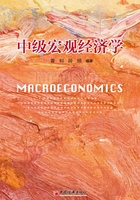
二、财政政策初步
在现实的世界,财政政策可以是多种多样的。这里我们将其笼统地归为两类:政府购买g的变化和税收t的变化。注意:只有g或t的变化,才能被称作一种财政政策。
政府购买的变化
政府购买g的变化,记为Δg≡g2-g1,造成的影响首先反映在总需求之中的自发需求部分增加,经过乘数作用,使得总需求变化:

表现为IS曲线向右移动Δy(图2-17)。

图2-17 政府购买变化的表现
给定其他条件不变,收入的扩张影响货币市场均衡,使得利率上升,进而引起经济中的投资需求减少。表现为LM曲线向上倾斜(而非水平),因此IS曲线与LM曲线的交点向右移动的距离小于Δy。
用代数式表示,可以首先由总需求方程的微分形式:

这里我们只考虑政府购买g的变化对于总需求的影响,故令:
dt=dnx=dM=dP=0
于是前式简化为:

⇒

税收的变化
政府净税收t的变化,记为Δt≡t2-t1,首先影响影响居民可支配收入,从而影响总需求之中的消费需求:
Δc=c2-c1=-c′·Δt
再经过乘数作用,使得总需求变化:

表现为IS曲线向右移动Δy(图2-18)。

图2-18 税收变化的表现
给定其他条件不变,收入的扩张影响货币市场均衡,使得利率上升,进而引起经济中的投资需求减少。表现为LM曲线向上倾斜(而非水平),因此IS曲线与LM曲线的交点向右移动的距离小于Δy。
用代数式表示,同样由总需求方程的微分形式:

这里我们只考虑政府净税收t的变化对于总需求的影响,故令:
dg=dnx=dM=dP=0
于是前式简化为:

⇒

财政政策的挤出效应
无论是增加政府购买g还是减少税收t,都会起到增加总需求的作用,因此称为扩张性财政政策;反之,则称为收缩性财政政策。
对比政府购买g还是减少税收t的政策效力:

我们首先可以发现,如果将“同等程度地”增加政府购买和减少税收相比,前者的扩张效果大于后者。原因在于,增加的政府购买直接进入总需求,而减少的税收则要通过影响居民可支配收入来影响总需求,之间经过了边际消费倾向的削弱。
无论是增加政府购买g还是减少税收t,在增加总需求的同时,都会(通过影响货币市场均衡)引起利率r的上升和投资需求i(r)的减少,这一通过利率的变化引起的投资和总需求的变化,抑制了扩张性财政政策的效力。这一作用被称作扩张性财政政策的“挤出效应”(Crowding-out Effect)。
特别引起关注的是:政府购买增加对于投资的挤出,如图2-19所示,图中Δy′=y3-y2表示的就是挤出效应,这一效应与财政政策的作用方向是相反的。

图2-19 挤出效应
直观上看,挤出效应的大小取决于IS曲线和LM曲线的斜率:IS曲线越平缓(斜率的绝对值越小),LM越陡峭(斜率的绝对值越大),挤出效应越大;反之,挤出效应越小。
也可以通过代数表达式看出这一点。我们已经得到政府购买一定的增加dg对于总需求的影响:

这时总需求的一定的变化dy,意味着利率r的多少变化?注意到LM曲线在整个过程中并未发生移动,而我们在此前已经得到LM曲线斜率的表达式:

因此:

接下来,利率r一定的变化dr,意味着投资需求i的多少变化?由于这一变化直接来自投资函数i=i(r),因此:

于是我们可以得到挤出效应的表达式:
